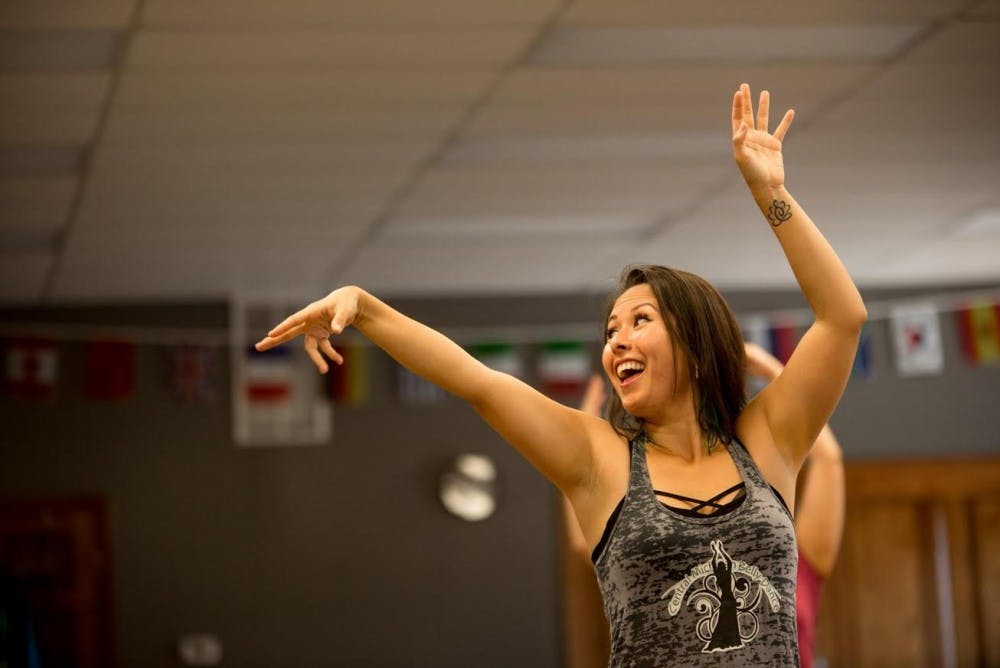Associate psychology professor discusses passion for belly dancing

When Kimberly O’Brien is not teaching psychology, someone might find her practicing the art of belly dancing.
O’Brien has been an associate professor of psychology at Central Michigan University since 2010. She studies health in the workplace and teaches psychology classes.
Despite a career in social sciences, O’Brien has a long-standing passion for belly dancing and runs her own club called Central Michigan Belly Dance in Lake Isabella. She also leads her belly dancing classes through Off-Broadway Performing Arts studio. The club’s Facebook page can be found here.
She practices many different forms of the dance, including different forms of cabaret and tribal belly dancing. She even mixes styles while maintaining respect for the dance's culture.
Central Michigan Life sat down with O’Brien to discuss her love of both psychology and belly dancing and some of the misconceptions people have about this form of dancing.
CM Life: When did you first start belly dancing?
O’Brien: "I first started belly dancing in 2002 in a group fitness program where I went to grad school. I was focusing a lot on academics and I needed a release for my creative energy and getting my mind off work. I went into it without expectation and it was a spontaneous decision. I saw they had a free class so I took it. I was bad at it at first and it took a while to grow on me."
How long did it take to grow on you?
"(For) probably the first six months, I looked terrible. I didn’t look like the instructor. I loved watching her do it and I was frustrated with my body for not being able to do it. But I stuck with it. I’m a stubborn person and when I feel like I can’t do something I just have to try that much harder."
When were you first interested in psychology?
"When I was 13 years old. I thought I was going to be a doctor, but my brother cut himself very badly. This thick, purple blood came out of his leg and I was like 'I can’t handle this.' I was still interested in deviations and people being different from one another. That drew me to clinical psychology, which I think is how a lot of people start in psychology. But when you get involved in clinical (psychology), you find it difficult because these people are living difficult lives. You need a special kind of resilience that I don’t have, so I work now in industrial-organizational psychology."
How do you maintain any kind of curiosity with psychology?
"I teach a health psychology class and ask 'Why do people smoke when they know it’s bad for them?' and 'How can we manage pain aside from opiates?' Those are the kinds of questions I have and I can explore those in my role (at CMU)."
Do you find that there’s a crossover between teaching belly dancing and psychology?
"When I teach psychology, I get a lot of examples from belly dancing, but I try not to mention them. I know it’s narrow and specific so I can’t say 'this is like when you’re trying to do an Egyptian shimmy and you do Moroccan shimmy instead.' Nobody is going to get that. I find that teaching belly dancing and psychology have a lot in common. For example, you can’t just present something one way because everyone learns in a different way."
What are some misconceptions people have about belly dancing?
"One is that belly dancers are exhibitionists. Or that we do it because we like people to look at our bodies. But a lot of belly dancers are reserved in real life. The reason why we sometimes costume in a way that highlights our feminine qualities because it’s hard to see hip movements unless you show some bling on your hips. In order to highlight our movements, we costume to show (the movements off)."
"Another misconception is that belly dancing is only for thin people. I find the body positivity in the belly dancing community is progressive. It’s at the forefront where we say, 'anybody can dance.' You don’t have to come in and put on a sequin bra. We want you to feel what’s comfortable for you. If you don’t feel comfortable in a sequin bra, your movement will show that and that’s not what we want."
"Another is that some people fetishize belly dancing. This is very different from exotic dancing. The goals are completely different. The goals in belly dancing are musicality and emotional expression. Belly dance is about feeling the music and showing people what the music is doing."
Do you try to stick with one style of belly dancing? Do you not mix styles out of respect?
"I will mix but I will learn the rules first. If you want to break the rules, you got to learn the rules. I defer to the people. If someone came in and told me I’m not doing my Egyptian shimmy right, I would say 'you know better than me, show me how to do it.' I wouldn’t be like 'no, I know better because I’ve been doing it since 2002.' It’s a cultural dance."
What tips would you give to someone who wants to start belly dancing?
"Sometimes people go online, and they see someone famous and they're like 'oh, I want to look like that.' But no dancer ever looks like another dancer. YouTube is good to get inspiration but it’s bad for setting goals for yourself. That’s not your standard. Everybody’s body looks different when they dance."






